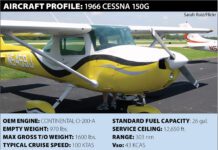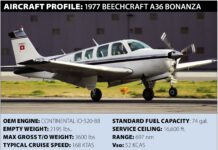Long cross-country flights are my favorite. The cruise portion is relatively easy, with plenty of time to plan ahead, monitor weather, etc., as the world literally slides by underneath. Going places on my own schedule with friends and family is one of the main reasons I learned to fly in the first place.
But cross-countries do have their drawbacks. The need for more-detailed flight planning is obvious, along with the uncertainty of what one might find in the way of services and fuel availability on landing at an unfamiliar destination. It’s a lot different than bouncing around the traffic pattern or zooming off to a nearby familiar airport for a hundred-dollar hamburger. And then there’s weather.
The preflight action regulation, FAR 91.103, requires the pilot to “become familiar with all available information concerning the that flight,” including “alternatives available if the planned flight cannot be completed.” For many flights, that can simply mean turning around and going back to the local airport. For long-cross-countries, turning around is less of an option. I’ve never flown to a destination, shot an approach, missed it and diverted to my filed alternate. I’ve always gotten in the first time or diverted to a different airport before reaching the planned destination. Sometimes, the diversion was for weather or to refuel after dealing with headwinds.
Picking an alternate can be its own art, with potential for multiple variations and limitations. Sometimes we have to settle for “close enough” to our destination, call it a night and finish up in the morning. Doing so makes even more sense when you’re tired. Here’s an example of why, and a cautionary tale about bypassing your alternate’s good VMC to shoot an ILS to minimums 60 miles away.
Background
On March 8, 2022, at about 1846 Central time, a 1979 Cessna 182Q Skylane was destroyed when it collided with terrain while executing the ILS Runway 16 approach to Northwest Florida Beaches International, in Panama City, Fla. The instrument-rated private pilot (male, 65) and his passenger were fatally injured. Night instrument conditions prevailed.
The day’s first leg was from the pilot’s home base in Midland, Mich., to McMinnville, Tenn. The pilot purchased 74 gallons of fuel and the airplane departed McMinnville about 1554. As it neared Panama City after about 2:45 hours en route, Tyndall Approach cleared the flight straight-in for the ILS to 16. The local controller advised the weather included two miles of visibility under a 200-foot ceiling, the procedure’s decision height.
On the approach, ATC issued a low-altitude alert and advised that the radar controller observed the Skylane deviating to the right of the final approach course. Shortly, ATC said, “There are other airports nearby with better weather conditions.” The pilot replied, “Alright, we’ll try this down to minimums and go around if need be.” About 12 seconds later, the controller stated that the airplane appeared to be “drifting a little to the right” and then “well to the right.” No further communications were received from the Cessna.
Investigation
The heavily fragmented wreckage came to rest in terrain wooded with 100-foot-tall trees, 1.55 nm from the runway threshold. The airplane’s angle of descent through the trees was about 18 to 20 degrees. All major components of the airplane were located in the debris path. The three-blade propeller had sheared from the propeller flange. Its blades all exhibited leading-edge gouging, chordwise scratches and torsional twisting.
Review of the flight’s ADS-B data found the airplane’s track continuously deviated left and right from the initial approach fix to the accident site, and included momentary climbs and descents. At both the initial and final approach fixes, the airplane was below the published minimum altitudes by about 500 and 700 feet, respectively. The final ADS-B data point recorded the airplane at 75 feet msl and a groundspeed of 144 knots on a 130-degree ground track.
The pilot received his instrument rating on June 27, 2019, after two disapprovals, once for lack of situational awareness and improper task management during partial panel operations, and once for a full-scale glideslope deflection. According to an individual who had flown with him as a safety pilot, the accident pilot would typically hand-fly approaches, perhaps because the autopilot had a persistent altitude management problem, resulting in oscillations that would eventually reach 1500 fpm climbs and descents.
The Panama City terminal forecasts called for deteriorating weather. One issued at 1140 advertised at least six sm of visibility with scattered clouds at 2500 feet agl. At 1721, while the airplane was en route to ECP, another forecast was issued for Panama City, calling for, at 2000, visibility of one statute mile in mist and an overcast ceiling at 500 feet agl. Beginning at about 1700, IFR conditions were reported and conditions continued to deteriorate throughout the evening. At 1756, about 45 minutes before the Skylane began its approach to Panama City, conditions included visibility of four statute miles in mist and a broken ceiling 400 feet agl. Sunset occurred at 1747, and civil twilight ended at 1811.
The pilot’s alternate airport, in Dothan, Ala., was about 60 nm north of Panama City, but also was within 30 miles of the flight’s route 31 minutes before the accident. Dothan’s weather at 1753 included visual conditions with calm wind.
Probable Cause
The NTSB determined the probable cause(s) of this accident to include: “The pilot’s deviation from the final approach course during a night instrument approach with low instrument meteorological conditions, which resulted in an impact with heavily wooded terrain. Contributing to the accident was the pilot’s decision to continue the approach after being warned of his flightpath deviations and his lack of experience in instrument conditions at night.”
On one level, it’s hard to fault the pilot for taking a look at the destination. But a glance was all he should have needed, especially with the low-altitude alerts and failure to maintain the final approach course. Both suggest a lack of proficiency, which resulted in an unstable approach. I’d also suggest fatigue was a factor—the pilot had already flown almost seven hours that day, possibly without the autopilot, and he wasn’t on the ground yet.
If the first warning from ATC didn’t get the pilot’s attention, the second one should have. It clearly was time for a missed approach and a vector direct to the VMC at Dothan. In hindsight, the decision to bypass Dothan was a poor one, probably thanks to not monitoring the deteriorating conditions at Panama City. But when the approach started going off the rails would have been a good time to call it quits and fly back to the alternate airport.
 One thing many pilots tend to forget: When filing an IFR flight plan, including an alternate airport always is the default. The way FAR 91.169 reads, you don’t have to file an alternate unless BOTH of the following conditions are true: The airport has a published instrument approach procedure AND the weather forecasts for at least one hour before and one hour after the ETA are a 2000-foot ceiling or better and three statute miles of visibility. Filing into VFR-only airports like my home plate means I always have to list an alternate. Fortunately, there’s an ILS 10 minutes away.
One thing many pilots tend to forget: When filing an IFR flight plan, including an alternate airport always is the default. The way FAR 91.169 reads, you don’t have to file an alternate unless BOTH of the following conditions are true: The airport has a published instrument approach procedure AND the weather forecasts for at least one hour before and one hour after the ETA are a 2000-foot ceiling or better and three statute miles of visibility. Filing into VFR-only airports like my home plate means I always have to list an alternate. Fortunately, there’s an ILS 10 minutes away.
Another consideration is the IFR fuel requirements in FAR 91.167. Presuming an alternate airport is required and considering weather reports and forecasts, the airplane must take off with enough fuel to a) fly to the intended destination, b) then fly to the alternate airport and, c) have at least 45 additional minutes of fuel aboard. Note that there’s no requirement to have fuel for the approach and missed approach, and the 45-minute reserve must be at normal cruising speed.



